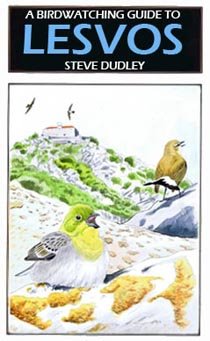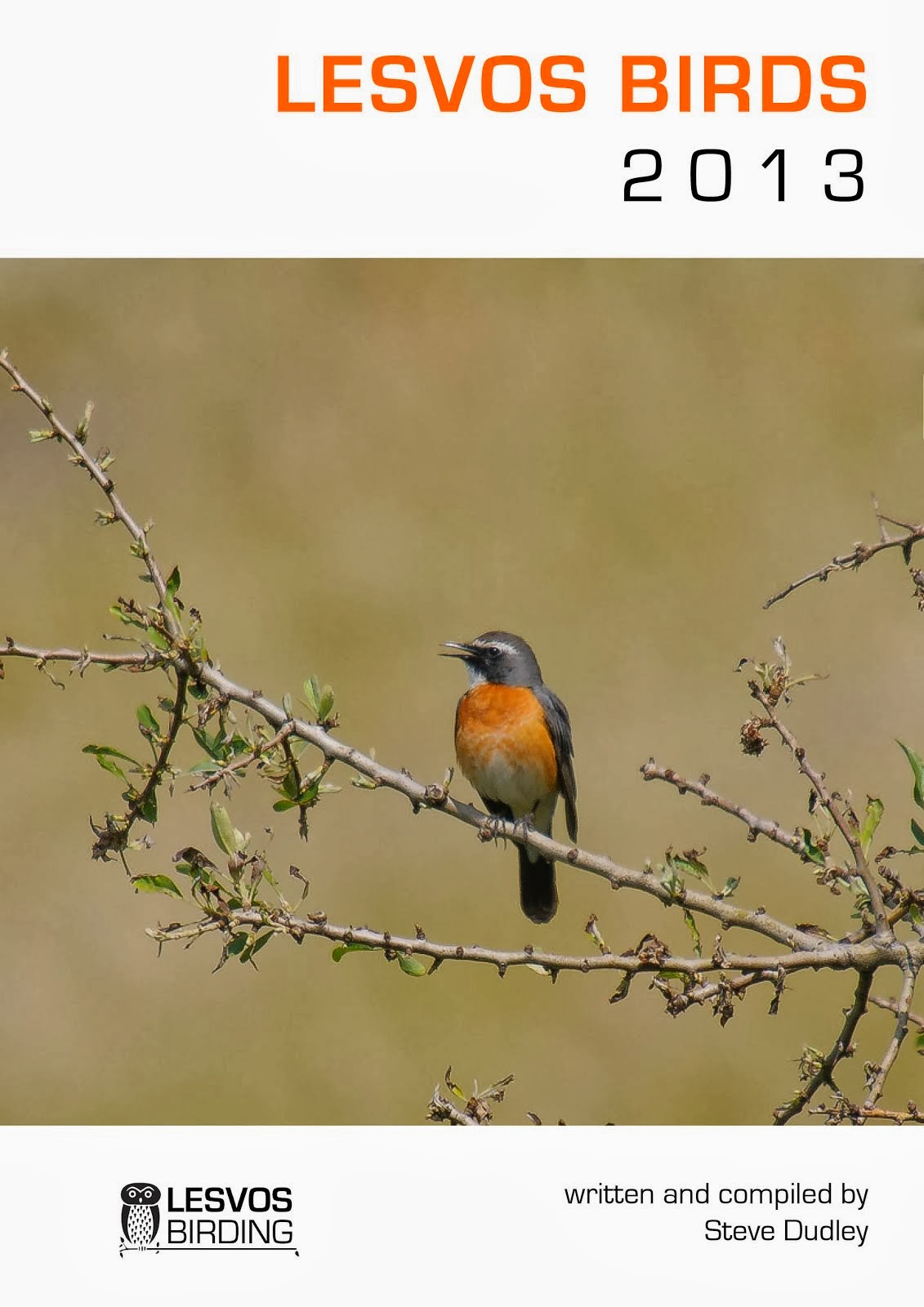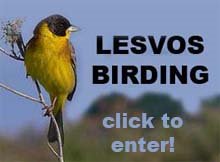Sunday, October 31, 2004
God they're gorgeous
In what was a non-birding weekend, I managed to get to Beachy Head (site tick!) for an hour or so. Despite it teeming with bodies, I was delighted to find a cracking pair of Firecrests feeding together in one group of bushes right by the Beachy Head pub. The male really was a (fire) cracker!
Thursday, October 28, 2004
Ovenbird - R.I.P
Ovenbird
St Mary's, Isles of Scilly
Found, Monday 25 October 2004
Died, Thursday 28 october 2004

'Digibinned' using my LEICA Ultravid 8x42s and Nikon Coolpix 995
Alas, it went the same way as most Ovenbirds found on this side of the Atlantic, and the Cream-coloured Courser which also died in care this morning.
St Mary's, Isles of Scilly
Found, Monday 25 October 2004
Died, Thursday 28 october 2004

'Digibinned' using my LEICA Ultravid 8x42s and Nikon Coolpix 995
Alas, it went the same way as most Ovenbirds found on this side of the Atlantic, and the Cream-coloured Courser which also died in care this morning.
Wednesday, October 27, 2004
Ovenbird! - now we're cookin'
Ovenbird. St Mary's, Isles of Scilly

'Digibinned' using my LEICA Ultravid 8x42s and Nikon Coolpix 995
Just a month a go I was thinking that I might be in for my first ever tick-free year. But nah, birding can be cruel and it can be magic, and running up to today I'd added Western Sand and Cream-coloured Courser in the last few weeks.
Resting on my laurels and thinking I'd seen the best bird I could get to of the autumn, the news of an Ovenbird on Scilly was shattering. Another bird with mythical status!
With a heap of work to get through I worked early morns and late evenings Monday and Tuesday so that I could afford Wednesday in the field. So, setting off at 11.00pm last night, I headed south-west.
I arrived at Penzance in time for a kip before relocating to Tesco for breakfast and to wait for news of the Ovenbird. I hadn't booked a chopper flight as if the bird disappeared (or died!) overnight, I would lose my £87 if I cancelled the ticket. But with an incoming storm already gusting near-gale force, Skybus and the Scillonian III cancelled for the next two days, would there not be a queue of hopeful birders waiting to rush for the few remaining seats at the heliport?
Just after 9.00am news came through that the Ovenbird was still present, so I legged it to the heliport and walked straight on to the next chopper flight to St Mary's. I was shocked to see only four other birders on the flight (and empty seats!) - appen the rough weather had p[ut pay to more traveling down (and it was mid-week after all).
We arrived at the site near Innisidgen, St Mary's at about 10.25am. The bird hadn't been seen since the 9.00am sighting, when it briefly appeared and walked off into ground cover. Rollox! The wind then picked up some more (gale force by now!) and the rain started. And it didn't sop for nearly two hours. If you weren't stood behind a tree, then it was akin to being bucketed with water. It wasn't good!
About two hours later it ceased and within minutes the sun came out - nice, bright and very warm. Many of us spread out to look for the Ovenbird. I soon located it with another birder in a sunny and windy hollow. My first view wasn't what I was hoping for. There, almost flat to the very wet ground, was a sodden bird with both its wings, tail and legs spread and head looking up to the sky. Jeez, I thought it was dead. Then it moved. We called other birders over and the bird, which was probably sunbathing in order to get dry, began to move, but each time it attempted to stand it simply flopped to the floor. The poor sod was knackered!
The assembled birders viewed it as it just sat in the wind and sun, slowly looking to be drying. It was agreed that we would attempt to catch it and stick it in a hat under someone's jumper and warm it up and to get it dry. As one guy was about to clasp his hands around it, it flew weakly back to the area it had spent the last couple of days feeding. It began feeding actively straight away, and in the sun and wind, it soon began to dry out. As it continued to feed, it got progressively stronger and less doddery, but it was always weak and occasionally a gust of wind would topple it over. Its left leg was obviously injured (not broken) as it was stiff and slightly trailing.
There was a collective relief to see the little bugger up and feeding and perking up all the time. Its a horrid feeling watching a bird that is visibly dying right in front of you, so the better it looked, the better we all felt (selfish I know!).
Conditions weren't condusive for scope use, so I improvised and hand-holding my Ultravid 8x42s, I set my Nikon Coolpix to the bottom end of the optimum macro setting and shooting at a max of 1/60th of a sec, I managed these half-decent record shots! People around me were amazed at the results, as I am, at my first ever 'digibinning'.

Just look at that crown!

'Digibinned' using my LEICA Ultravid 8x42s and Nikon Coolpix 995
I watched the Ovenbird for a good while before feeling that I was now missing some birding elsewhere on the island. Heading back up towards Trenowerth Farm and the place was chuffed with birds - Chiffchaffs in particular where everywhere. A Woodcock flew through. A couple of Black Redstarts suddenly appeared in front of me. A Merlin fought the wind overhead. And dozens upon dozens of Redwings bombed around overhead. Wow!
I picked my route for the next two hours, slowly heading towards the airport and making use of as much north-west facing cover (from the gale force SE wind!). The whole Trenowerth area was dripping with Chiffies and I managed a very grey (northern?) Willow Warbler and a Common Redstart to go with my brace of Black Reds.
Telegraph continued the theme. More Black Reds, including 11 along one field edge. Chiffies along walls. Skylarks. Mipits. I noticed everyone else was taking the road back to town, so I thought I would brave the Golf Course. Walking across the first fairway I was blown off my feet! Now that was a first. Wandering around I flushed 19 Snipe and another Woodcock. The sheltered treeline leading down to the club house held a minimum of 39 Chiffies and 9 more Black Reds.
Porthloo was mild (on the sheltered side of the island) and held a single Med Gull and another smattering of Black Reds and Chiffs. I headed through the Incinerator and failed to latch on to the Waxwing or Yellow-browed, but managed to catch up with the Grey Phal on a really wild Old Town Bay. The phal was literally blown out of the water and dumped on to the road so it was picked up and relocated to nearby Lower Moors pool.
A windy Old Town Bay

What a day. Despite the weather, one of the best birding days I've had in an age.

'Digibinned' using my LEICA Ultravid 8x42s and Nikon Coolpix 995
Just a month a go I was thinking that I might be in for my first ever tick-free year. But nah, birding can be cruel and it can be magic, and running up to today I'd added Western Sand and Cream-coloured Courser in the last few weeks.
Resting on my laurels and thinking I'd seen the best bird I could get to of the autumn, the news of an Ovenbird on Scilly was shattering. Another bird with mythical status!
With a heap of work to get through I worked early morns and late evenings Monday and Tuesday so that I could afford Wednesday in the field. So, setting off at 11.00pm last night, I headed south-west.
I arrived at Penzance in time for a kip before relocating to Tesco for breakfast and to wait for news of the Ovenbird. I hadn't booked a chopper flight as if the bird disappeared (or died!) overnight, I would lose my £87 if I cancelled the ticket. But with an incoming storm already gusting near-gale force, Skybus and the Scillonian III cancelled for the next two days, would there not be a queue of hopeful birders waiting to rush for the few remaining seats at the heliport?
Just after 9.00am news came through that the Ovenbird was still present, so I legged it to the heliport and walked straight on to the next chopper flight to St Mary's. I was shocked to see only four other birders on the flight (and empty seats!) - appen the rough weather had p[ut pay to more traveling down (and it was mid-week after all).
We arrived at the site near Innisidgen, St Mary's at about 10.25am. The bird hadn't been seen since the 9.00am sighting, when it briefly appeared and walked off into ground cover. Rollox! The wind then picked up some more (gale force by now!) and the rain started. And it didn't sop for nearly two hours. If you weren't stood behind a tree, then it was akin to being bucketed with water. It wasn't good!
About two hours later it ceased and within minutes the sun came out - nice, bright and very warm. Many of us spread out to look for the Ovenbird. I soon located it with another birder in a sunny and windy hollow. My first view wasn't what I was hoping for. There, almost flat to the very wet ground, was a sodden bird with both its wings, tail and legs spread and head looking up to the sky. Jeez, I thought it was dead. Then it moved. We called other birders over and the bird, which was probably sunbathing in order to get dry, began to move, but each time it attempted to stand it simply flopped to the floor. The poor sod was knackered!
The assembled birders viewed it as it just sat in the wind and sun, slowly looking to be drying. It was agreed that we would attempt to catch it and stick it in a hat under someone's jumper and warm it up and to get it dry. As one guy was about to clasp his hands around it, it flew weakly back to the area it had spent the last couple of days feeding. It began feeding actively straight away, and in the sun and wind, it soon began to dry out. As it continued to feed, it got progressively stronger and less doddery, but it was always weak and occasionally a gust of wind would topple it over. Its left leg was obviously injured (not broken) as it was stiff and slightly trailing.
There was a collective relief to see the little bugger up and feeding and perking up all the time. Its a horrid feeling watching a bird that is visibly dying right in front of you, so the better it looked, the better we all felt (selfish I know!).
Conditions weren't condusive for scope use, so I improvised and hand-holding my Ultravid 8x42s, I set my Nikon Coolpix to the bottom end of the optimum macro setting and shooting at a max of 1/60th of a sec, I managed these half-decent record shots! People around me were amazed at the results, as I am, at my first ever 'digibinning'.

Just look at that crown!

'Digibinned' using my LEICA Ultravid 8x42s and Nikon Coolpix 995
I watched the Ovenbird for a good while before feeling that I was now missing some birding elsewhere on the island. Heading back up towards Trenowerth Farm and the place was chuffed with birds - Chiffchaffs in particular where everywhere. A Woodcock flew through. A couple of Black Redstarts suddenly appeared in front of me. A Merlin fought the wind overhead. And dozens upon dozens of Redwings bombed around overhead. Wow!
I picked my route for the next two hours, slowly heading towards the airport and making use of as much north-west facing cover (from the gale force SE wind!). The whole Trenowerth area was dripping with Chiffies and I managed a very grey (northern?) Willow Warbler and a Common Redstart to go with my brace of Black Reds.
Telegraph continued the theme. More Black Reds, including 11 along one field edge. Chiffies along walls. Skylarks. Mipits. I noticed everyone else was taking the road back to town, so I thought I would brave the Golf Course. Walking across the first fairway I was blown off my feet! Now that was a first. Wandering around I flushed 19 Snipe and another Woodcock. The sheltered treeline leading down to the club house held a minimum of 39 Chiffies and 9 more Black Reds.
Porthloo was mild (on the sheltered side of the island) and held a single Med Gull and another smattering of Black Reds and Chiffs. I headed through the Incinerator and failed to latch on to the Waxwing or Yellow-browed, but managed to catch up with the Grey Phal on a really wild Old Town Bay. The phal was literally blown out of the water and dumped on to the road so it was picked up and relocated to nearby Lower Moors pool.
A windy Old Town Bay

What a day. Despite the weather, one of the best birding days I've had in an age.
Sunday, October 10, 2004
Wryneck - brightening up a dull day!

Returning from Scilly last night, both Katie’s and my euphoria of successfully twitching the Cream-coloured Courser was slightly tempered by news that we had missed a Wryneck on our home turf (found by Martin Coates's dog Sparky). Ouch! Still, we had Mr Creamy Courser under our belts, and Katie had also ticked Short-toed Lark, so life was pretty sweet.
For some time, Brian 'the natural' Stone, Katie and I had arranged some time ago to head out to the coast for a rare day out of area. Our plans were changed slightly in order to start at Langtoft for the Wryneck. With a clearing sky I wasn't too hopeful, but as we left Katie's, Mikey 'world of nature' Weedon called us to say he was watching 'the neck'. top man!
We arrived at the site and from the car we were able to get brief views of the Wryneck only feet in front of Mikey's digiscoping set-up. We quietly got out of the car out of view of the bird, but the bird was spooked and flew into a tree. Some 45 mins later it hadn't returned, so the three of us headed for the Lincs coast as planned.
The Lincs coast is a vastly underwatched area - and for good reason. With Yorkshire (White's thrush, OBP, Pallas's and Yellow-browed Warblers, RB Fly etc) and Norfolk/Suffolk (more Pallas's and yellow-broweds, RB Flies etc) dripping with birds, our anticipation and expectations were greatly heightened. But without good reason. Skeggie to Gib Point was dead! Goldcrests (and not that many) a couple of Chiffies (which I didn’t even see!), a Lesser Whitethroat (which I only heard) and star bird - a Woodcock (seen only by Katie and Brian!) - and that was it.
So, with no birds to look at I suggested heading back inland for another, and better, look at the Wryneck. Agreed. An hour or so later we were back at Langtoft and, driving through the gate we immediately spotted the Wryneck feeding along the kerbstones in front of us! Bloody marvellous! We spent the next hour or so getting closer, and closer, snapping and snapping. What a bloody wonderful creature. I'd seen Wrynecks well in the past, but nothing quite like this! (see Katie's photos).
For Katie's pics click here. For Brian's pics click here.
What a star!

Playing hide and seek

What you lookin' at?

Get in there!

Tongue action

Photos © Steve Dudley
Nikon Coolpix 995 | Leica APO Televid 77 with 20xWA eyepiece
Saturday, October 09, 2004
What a creamy cracker!
 With Mr Creamy Courser the Cream-coloured Cracker still lingering on the magical Isles of Scilly, the Katie 'Bogbumper' Fuller, Mark 'Wardy' Ward and myself had already secured earlier in the week the last three places on the 07.30h chopper this morning.
With Mr Creamy Courser the Cream-coloured Cracker still lingering on the magical Isles of Scilly, the Katie 'Bogbumper' Fuller, Mark 'Wardy' Ward and myself had already secured earlier in the week the last three places on the 07.30h chopper this morning. The Courser though decided to change its routine yesterday. No longer content living in the sheep fields of St Martin's it moved to the airport on St Mary's. Ouch! Saturday's chopper and plane traffic will be the busiest in weeks, so if it decides to stay around the airport it might get disturbed and shoot off which might take some relocating. Mind you, if it did stay around the airport, it would save us the time and hassle of legging it over to St Martin's.
So, we set off at 22.00h last night and arrived in Penzance at 04.00h this morning and managed a rather unsettled couple of hours sleep before transferring to the airport for our 07.30h chopper flight.
We got in the air five minutes early and arrived on St Mary's 20 minutes later. It was still quite dull and with no other birders likely to be out this early, it was up to us to find Mr Creamy Cracker for ourselves. Half an hours search around the terminal building drew a blank, so we decided to leave others searching this area and headed for the windsock to check the end of the main runway. The choppers and planes were using the other auxiliary runway due to the easterly winds, so it meant that the Giant's Castle end of the airfield was relatively undisturbed. In the howling 40+mph winds we could barely stand up in this exposed area with absolutely nothing to shelter us. We gave the place a grilling and were just about to head for Peninnis when Wardy's pager alerted us that the Courser was viewable from the terminal building! Result!
We legged it back round (very sweaty indeed!) and approaching the terminal building along the Old Town footpath we spotted the gathered birders looking down our side of the airfield. 'There it is!' I yelled 'on the ridge!'. We quickly set up our scopes. Even though the wind was howling and it was still very dull, I decided to get at least a record shot of Mr Creamy Cracker just in case I didn't get the opporuntity later in what was not worsening weather.
After about five minutes the Courser walked over the ridge so we moved up to the terminal building. Wardy mused about wanting to see it in flight, and after five mins, an incoming chopper duly helped as the Courser rose with all the other birds and flew, like an out of control Little Bittern in the strengthening wind, and headed off towards Old Town before pitching down in a grassy field - out of sight!
It had now started to pee down, so we decided to make our way across to Peninnis and look for the Short-toed Lark. Despite passing birders who told us it hadn't been seen this morning, we arrived at its favoured field as it was found - result! And what a star bird - the brightest autumn bird I'd ever seen.
The bird looked as fed up and wet as we were, so we continued around Peninnis picking up a single Chiffie and good views of a rather bedraggled Short-eared Owl looking for some cover, before arriving in Hugh Town and pitching ourselves down in Cafe En Route for a crackin cuppa. We were dripping! Wardy and I stripped off and little puddles formed under our hanging coats, scopes, bags etc. Katie sat there all togged up slowly dripping into her own puddle under her seat!
Refreshed, warmed and a little drier, we telephoned for a taxi to take us back to the airport for another view of the Courser. We watched it for a while in the pouring rain. It looked well and truly fecked off as it huddled down behind a pittasporum bush in a bulb field. It got up a couple of times, ran around on its leggy legs before returning to shelter. Poor sod.
A very wet and miserable Mr Creamy Courser

Two very wet, but happy, dirty twitchers

Well bugger the Courser - poor us! We were pee wet through again, so we made for the airport building and straight to the check-in desk. Although not due to fly off for another three hours, I enquired about an earlier flight back to Penzance and was handed three boarding cards for the next flight - 20 minutes later. Result!
Back in Penzance we made for Tesco for a hot lunch (and free in Wardy's case - another result!) before heading home, arriving back on the fen at 21.30h. Scilly and back in 22 hours. Result!
Photos © Steve Dudley
Nikon Coolpix 995 | Leica APO Televid 77 with 20xWA eyepiece
Wednesday, October 06, 2004
Solar moler
My little furry friend, Mr Mole, has been causing a bit of a do in the garden. He's taken up residence at the bottom end of the garden and each night burrows around and forms his little hills hither and thither. I wasn't too fussed at first, but when the ground began to get decidedly dodgy due to the many tunnels, and the mole hills just kept on mounting up, I thought it was about time something had to be done (even though the sparrows love to dust-bathe on the dry mole hills!).
Wanting a humane solution to my problem, I searched the web and discovered solar powered mole deterrents - or solar molers! I got mine ordered. It arrived. I unpacked it. I then stuck the solar sensitive top in the garden for three days to charge up the battery, stuck the thing in the most recent molehill (one from the previoius night) and hey presto! Ultrasonic beeps are now being transmitted through moledom and beyond. Success was instant. No new hills for two consecutive nights. Lets hope the solar moler keeps things that way!
My solar moler doing its job with old mole hills behind

Photos © Steve Dudley
Nikon Coolpix 995
Wanting a humane solution to my problem, I searched the web and discovered solar powered mole deterrents - or solar molers! I got mine ordered. It arrived. I unpacked it. I then stuck the solar sensitive top in the garden for three days to charge up the battery, stuck the thing in the most recent molehill (one from the previoius night) and hey presto! Ultrasonic beeps are now being transmitted through moledom and beyond. Success was instant. No new hills for two consecutive nights. Lets hope the solar moler keeps things that way!
My solar moler doing its job with old mole hills behind

Photos © Steve Dudley
Nikon Coolpix 995
Tuesday, October 05, 2004
Sunflowers @ Farcet Fen
By 'eck! What's this? A field margin strip of sunflowers on the fen. Fantastic!
Sunflower strip on Farcet Fen

Today I decided to take a closer look, and whilst doing so, met Martin, the manager of this and two other such strips on the fen planted for game cover. Martin explained that his small shoot were looking at ways of creating better cover strips for pheasants which not only looked more attractive than the horrible looking traditional maize strips, but were also better for the pheasants and the local wildlife community.
Well I think they've hit on a winner with this. The strips have been planted under the new 5m field margin scheme. Sunflowers and quinoa (a South American version of Fat Hen) have been planted together to provide a wealth of food once the plants have ripened and dropped their seed. Plenty of sun reaches the ground below the bushy stand of taller plants, and the whole place is alive with insects. Whilst I was there a male Yellowhammer was buzzing around the strip.
The winter will be the time to tell if it has worked as a cover strip. As long as the plants remain standing and provide decent cover through to Jan/Feb time, then it will be deemed a success. Lets just hope all this free sunflower and quinoa seed doesn't take too many birds away from my garden!

Sunflower strip on Farcet Fen

Today I decided to take a closer look, and whilst doing so, met Martin, the manager of this and two other such strips on the fen planted for game cover. Martin explained that his small shoot were looking at ways of creating better cover strips for pheasants which not only looked more attractive than the horrible looking traditional maize strips, but were also better for the pheasants and the local wildlife community.
Well I think they've hit on a winner with this. The strips have been planted under the new 5m field margin scheme. Sunflowers and quinoa (a South American version of Fat Hen) have been planted together to provide a wealth of food once the plants have ripened and dropped their seed. Plenty of sun reaches the ground below the bushy stand of taller plants, and the whole place is alive with insects. Whilst I was there a male Yellowhammer was buzzing around the strip.
The winter will be the time to tell if it has worked as a cover strip. As long as the plants remain standing and provide decent cover through to Jan/Feb time, then it will be deemed a success. Lets just hope all this free sunflower and quinoa seed doesn't take too many birds away from my garden!

Sunday, October 03, 2004
If we all go down to Minsmere . . .
. . . we'll see some chuffin curlew! Well,lets admit it, apart from a whacky bill and a great call, I can't see what else curlews have going for them. And to drive for two hours to see . . . er . . . a small curlew? Hey - lets party!
But hold on, whats this? A snake in the grass it looks like!
Adder

But hold on, whats this? A snake in the grass it looks like!
Adder

Subscribe to:
Posts (Atom)








